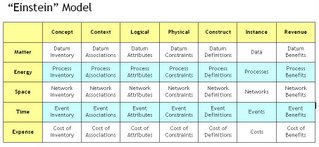 R. Buckminster Fuller said that the tetrahedron was the simplest system. Albert Einstein said that such a system was composed of time, space, energy and matter. S. Raganathan agreed with Einstein when he created his colon classification system saying that a system has four components and a class.
R. Buckminster Fuller said that the tetrahedron was the simplest system. Albert Einstein said that such a system was composed of time, space, energy and matter. S. Raganathan agreed with Einstein when he created his colon classification system saying that a system has four components and a class.
However, John Zachman believed that a computer system had six components. The Zachman Framework contains Time (when), Space (where), Energy (how), Matter (what) and two more components Cause (why) and Observer (who). So let's take Zachman's framework and strip those two components away. We will also reorient the framwork.
 Now, let's look at this "framework" in some detail using Zachman's terms.
Now, let's look at this "framework" in some detail using Zachman's terms. The framework has four "focuses":
- Matter
- Energy
- Space
- Time
The framework also has six "perspectives:
- Concept
- Context
- Logic
- Physic
- Construct
- Instance
You probably have noted that I have added an extra row and an extra column. Expense is the cost of the phase. Revenue is benefit of the components. The bottom right cell contains the cost/benefit ratio.
Labels: einstein, fuller, raganathan, systems, zachman



0 Comments:
Post a Comment
<< Home